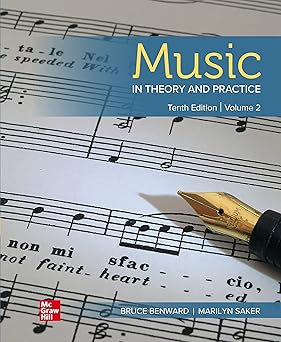Key Highlights
- •Covers advanced music theory including chromatic harmony, form, and counterpoint.
- •Part of the best-selling, widely adopted 'Music in Theory and Practice' textbook series (10th Edition).
- •Features numerous musical examples and practical exercises for skill development.
Description
Ready to take your music theory knowledge to the next level? Dive into (PDF)Music in Theory and Practice Volume 2 10th Edition by Bruce Benward and Marilyn Saker. This isn't your basic intro book; it's the essential next step for really understanding how music works beyond the fundamentals.
Who is this book for? It’s specifically designed for university-level music students who have completed their introductory music tehory courses (like those using Volume 1). Aspiring composers, arrangers, music educators, and serious musicians looking to deepen their grasp of harmony, counterpoint, and musical form will find it incredably useful. If you're ready to move past diatonic harmony, this book is definately for you.
What problem does this book solve? Feeling stuck after learning the basics? Wondering how composers create rich textures with chromatic harmony or structure longer pieces? This volume bridges that gap. It tackles the more complex topics that Volume 1 introduces, helping you undestand and analyze advanced tonal music and even introducing concepts from the 20th and 21st centuries. It provides clear explanations and practical application for concepts that can often feel abstract or overwhelming.
What will you gain from reading it? You'll master advanced harmonic techniques like secondary dominants, modulation strategies, borrowed chords, the Neapolitan chord, and augmented sixth chords. You'll explore larger musical forms like sonata, rondo, and variations, plus gain insights into contrapuntal techniques. This book help you develop sophisticated analytical skills and provides tools to enhance your own compositional work. Its focus on 'practise' means you'll be applying what you learn through numerous exercises and musical examples drawn from real repertoire.
Why is it worth reading? As part of the highly respected and widely adopted Music in Theory and Practice series, this 10th edition represents decades of refinement in music theory pedagogy. Its known for its clarity, logical progression, and comprehensive coverage. This book provide the solid foundation needed for upper-level music studies and a lifelong engagement with music analysis and creation. Don't miss out on this essential resource for advanced music theory study! Get your PDF copy today and start mastering complex musical ideas!
FAQ
Is this book okay for someone just starting music theory?
No, this is Volume 2 and assumes you've already completed a foundational music theory course, like the material covered in Volume 1 of this series. It jumps right into more advanced topics.
Do I absolutely need Volume 1 before using Volume 2?
Yes, it's highly reccomended. Volume 2 builds directly on the concepts, terminology, and skills introduced in Volume 1. You'll likely struggle without that foundation.
What kind of music examples are in the book?
The book uses a wide range of examples, primarily drawn from Western classical music repertoire (Baroque, Classical, Romantic periods), but the 10th edition may also include some examples from later periods to illustrate specific concepts.
Are there practice exercises included?
Absolutly! A major strength of this series is its focus on practical application. The book includes numerous exercises, often paired with musical examples, to help you solidify your understanding.
What are the main differences between Volume 1 and Volume 2?
Volume 1 typically covers music fundamentals, scales, intervals, basic chords, voice leading, and diatonic harmony. Volume 2 delves into more advanced topics like chromatic harmony (secondary chords, modulation, modal mixture), larger forms (sonata, rondo), counterpoint, and introduces 20th/21st-century techniques.
Is this the most current edition available?
This product page is for the 10th Edition of Volume 2. While publishing cycles vary, this is a relatively recent and widely used edition for college courses.
Reader Reviews
About the Author
Bruce Benward (late) was a distinguished professor emeritus known for his significant contributions to music theory pedagogy. His 'Music in Theory and Practice' series, co-authored in later editions by Marilyn Saker, a respected music theorist and educator herself, has been a cornerstone of North American university music curricula for decades, shaping the theoretical understanding of countless musicians.
